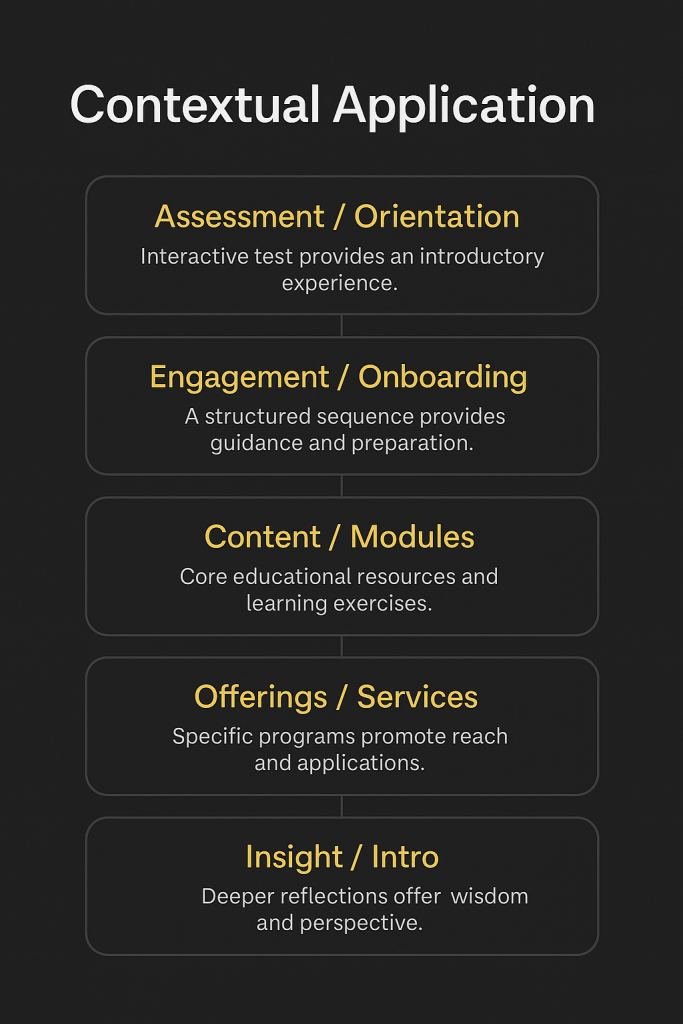A Scientific Architecture for Human Systems Design
“The structural logic behind all coherent human engagement systems.”
The Theory
Every robust scientific theory begins by naming its assumptions.
The Living Matrix Framework does the same—explicitly identifying the principles that underlie any coherent human-engagement system.
Working Assumptions
1. Human beings evolve.
2. Humanity evolves collectively.
3. Evolution follows recognizable patterns visible in nature, mathematics, and behavior.
4. These patterns can be represented as a repeatable process of orientation, engagement, transformation, and integration.
5. Any organization, product, or service that aligns with these patterns becomes self-correcting and adaptive.
Scope of the Theory
The Living Matrix Framework models how individuals and groups move through coherent stages of interaction.
It provides a replicable architecture—independent of content, industry, or belief system—for designing human-centered systems that evolve over time.
The Five-Layer Architecture
Every functional ecosystem—whether biological, social, or digital—moves through five repeating phases.
The Living Matrix organizes these into a Five-Layer Flow, a universal pattern of movement from first contact to integration.
| Layer | Function | Typical Business Parallel | User Experience Focus |
| Orientation | Establish awareness and Context | Marketing/Prospecting | Curiosity → Attention |
| Exploration | Build voluntary relationship | Qualification/Onboarding | Trust → Permission |
| Systemization | Deliver structured value | Presentation/Delivery | Clarity → Engagement |
| Application | Express value in practice | Partnership/ Collaboration | Mastery → Contribution |
| Integration | Reflect, measure, renew | Feedback / Referral | Insight → Evolution |

Core Insight
This flow is structural, not stylistic.
Different languages, markets, and tools may express it differently, but any complete engagement system must traverse these same five functions.
Principles of Coherence
The architecture operates by six governing principles:
1. Transparency of Assumptions — Make the worldview visible so users understand what the system believes about growth.
2. Consent-First Design — Every movement between layers is voluntary and explicit.
3. Feedback Loop — Each cycle ends in reflection (“3 Wins · 3 Frictions · 3 Insights”) to inform the next.
4. Fractal Alignment — Each component mirrors the pattern of the whole; coherence scales naturally.
5. Integration over Information — Transformation is the success metric, not data volume.
6. Adaptive Aesthetics — Form follows function; local language and culture customize expression without breaking structure.
These principles are the non-negotiable DNA of any Living Matrix implementation.
Structure vs. Content
| Fixed Elements | Flexible Elements |
| Five Layer Flow | Branding/Voice/Design |
| Consent Logic | Copy and tone |
| Transparency Protocol | Philosophy or domain |
| Feedback Loop | Tool Selection (Forms, CRMs, automations |
| Fractal Rhythm | Modules and methods |
| Integration Ethic | Pricing/Business Model |
Key Concept > The structure never changes—but what fills it can evolve infinitely.
This separation makes the framework both stable and scalable.
System Flow Logic
User Journey – Orientation → Exploration → Systemization → Application → Integration → (loops back)`
Each transition has:
- A human intention (Curiosity → Trust → Engagement → Contribution → Insight)
- A technical function (Entry Point → Qualification → Delivery → CRM/API → Analytics Loop)
Result: A self-learning system that combines human development flow with measurable data flow.
Technical Scalability
The Living Matrix Framework is platform-agnostic.
It can live on WordPress, Webflow, or any modern stack.
Key technical features
Modular Hosting: each layer = independent module, deployable or replaceable.
API Flexibility: data tagged per layer (`orientation_start`, `agreement_signed`, `module_opened`, `feedback_submitted`).
Automation Compatibility: integrates with CRMs or marketing platforms (HubSpot, HighLevel, ConvertKit).
Analytics Ready: simple gate-based metrics for flow health and user movement.
Security & Privacy: consent-driven data collection; minimal and transparent.
Engineering Principle: build once → duplicate anywhere → customize locally → measure universally.
Developer and Integrator Opportunity
The framework’s duplicability creates three scalable opportunities:
Matrix Template Hosting — Provide ready-to-deploy installations for different industries.
The Honeycomb of Coherence
Every spark of coherence forms a cell in a greater design.
The Honeycomb reveals how spirit and structure scale together —
the geometry of unity through diversity.
Matrix Builder Kit — An admin tool that clones the architecture and walks users through customizing content.
Matrix Analytics Layer — Cross-domain dashboard measuring coherence (completion, consent, reflection rates).
Outcome – A new category of infrastructure: > Conscious Relationship Management (CRM 2.0) — systems that optimize for consent and coherence rather than conversion alone.
Testing the Theory
Just as a scientific theory must be falsifiable, the Living Matrix Framework includes mechanisms to test itself.
Predictive Claim: If the five-layer structure and six principles are applied consistently, engagement will show measurable increases in:
* Voluntary participation rates
* Depth of understanding
* Repeat collaboration
* Quality of feedback
These can be measured through built-in metrics across duplicates.
Conclusion
The Living Matrix Framework offers a scientific, ethical, and scalable method for designing systems that evolve as their users do.
It transforms digital infrastructure from static funnels into living feedback ecosystems.
Structure is coherence. Coherence is scalability.